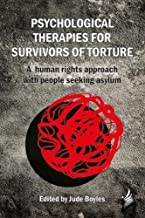
ISBN 978-1-910919-33-0, £24.99, Edited by Jude Boyles, PCCS Books Ltd
Seven years ago, in the autumn of 2011, I made a speculative phone call to a local table tennis club secretary in the hope of getting fit and using some of my childhood skills competitively. The chap I spoke to was called Malcolm, who I later discovered was from Congo-Brazzaville (Republic of the Congo).
Through him I met my future teammates – Ethiopian Abdiwali, Zambian Chone, Nigerian Hank and, later on, Iranian Hossein. Each had a story. Each one of them had left or fled something, be it Kenya’s refugee camps or Ahmadinejad’s regime with its pronounced shift away from human rights; not forgetting Malcolm’s own escape from ethnopolitical civil war.
Reviewing this book therefore feels like a natural extension of those early experiences. It feels like a profound duty of sorts in attempting to better understand other cultures and the horrors that exist far removed from our relatively safe shores.
Editor Jude Boyles has put together 17 varying, eclectic chapters. She has gently summoned some original writers such as Rajita Rajeshwar, Katie Whitehouse and Ann Salter. But mostly, she has allowed those traumatised by torture – whether real or anonymised amalgamations – to speak.
Francine, Marie, Mercy, Fila, Anton and Francois – to name just a few – are all real people when it comes to lived experiences of repeated rape, female genital mutilation (FGM), trafficking, beatings/sexual torture, being forced to witness unforgivable acts and the violent rupture of one’s attachment relationships. Their voices transmit not only the relentless, daily degradation of a human hell, but the raw injustice of power.
How can an adolescent, for example, ever remove the image of his mother being raped before his very eyes in a government detention facility? How is that even comprehensible, remotely coherent or within the bounds of what one expects from life?
Dissociation, post-traumatic stress disorder (PTSD), avoidance, vicarious trauma, shame and myelination are all covered in this book as either consequences, or fascinating insights regarding the developing brain, yet it is Colsom Bashir’s ‘Understanding shame with survivors of torture’ (Chapter 8) and Judith Lewis Herman’s 1992 classic Trauma and Recovery – referenced by almost every contributor – that represent the heart of this work.
Bashir’s argument is essentially that shame is a socially constructed phenomenon, that emotions are formed or dictated by received norms. We internalise social etiquette and therefore cultural narratives/boundaries are not subjective but rather created by that around us.
Take the plight of Fila – a once “independent, self-sufficient…pure and respectable” Iranian woman. Following her post-election peaceful protest, she was detained, humiliated and sexually tortured for 28 days. Her in-laws, as a consequence, viewed her as “contaminated woman”.
Such feckless, abominable reactions are all too common in situations that destroy identities, hence require healing and an impalpable resilience. This sad fact alone makes this an indispensable read for practitioners.
—
This review was first published in Private Practice, December 2018 issue, © BACP